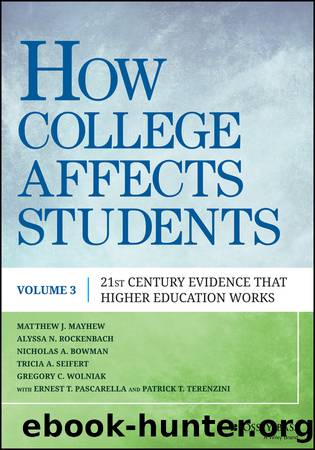How College Affects Students: Matthew J. Mayhew by unknow

Author:unknow
Language: eng
Format: epub
Publisher: John Wiley & Sons, Incorporated
Published: 2016-09-19T07:53:06+00:00
Tuition
Rising tuition costs have received a great deal of public attention and scrutiny. Over the past 40 years, the inflation-adjusted total for tuition and fees has more than tripled at four-year public and private nonprofit institutions, and this figure is now about two and a half times larger at public two-year institutions (College Board, 2014). While the increased cost of college may be a substantial barrier to college attendance, the research strongly suggests that tuition does not affect the persistence and degree attainment of students who are already enrolled in college.
Tandberg and Hillman (2014) examined the extent to which changes in a state's public tuition predict changes in bachelor's degree completion. Because they used a panel analysis to explore variation over time, their results controlled for all differences that exist across state public higher education systems. Changes in the public in-state tuition at four-year and at two-year schools were unrelated to bachelor's and associate's degree completion. Conducting an institution-level fixed-effects panel analysis, Zhang (2009) also found that changes in in-state tuition and fees were unrelated to changes in six-year graduation rates at four-year public universities; subgroup analyses found this nonsignificant pattern was consistent regardless of institutional type and level of state funding.
The vast majority of additional studies have identified no significant relationship between tuition and educational attainment (Bailey et al., 2006, 2010; Calcagno, Crosta, Bailey, & Jenkins, 2007a, 2007b; Calcagno et al., 2008; Chen & St. John, 2011; Dowd & Coury, 2006; Mamiseishvili, 2012; Titus, 2006a; Ver Ploeg, 2002; Wilson, 2007). The research that has identified significant relationships for tuition has mostly used institution-level data, and these find inconsistent results across analyses within the same study (Jacoby, 2006; Long, 2008; Porchea, Allen, Robbins, & Phelps, 2010; Scott et al., 2006; Shin, 2010). In fact, most of the occasional significant findings indicate that tuition is positively associated with persistence and attainment. These positive results probably occur because these models insufficiently account for differences across institutions and students. Consistent with this explanation, both Zhang (2009) and Tandberg and Hillman (2014) also found significant positive relationships before they implemented fixed-effects analyses.
The strong evidence for a lack of influence of tuition may be surprising given the seemingly intuitive role that finances play in educational decision making. However, the extent to which students pay for some or all of the stated tuition price varies dramatically both within and across institutions. Therefore, although there is seemingly no effect of tuition, net price (i.e., how much students actually pay for their enrollment) may affect retention and persistence. In addition, tuition may strongly influence students' decisions about which college to attend or whether to attend college at all, whereas the studies reviewed here almost exclusively examine whether students who have already enrolled in college progress in their degrees.
Download
This site does not store any files on its server. We only index and link to content provided by other sites. Please contact the content providers to delete copyright contents if any and email us, we'll remove relevant links or contents immediately.
| Administration | Adult & Continuing Education |
| Business School Guides | College Guides |
| Financial Aid | Graduate School Guides |
| Law School Guides | Medical School Guides |
| Test Preparation | Vocational |
Spare by Prince Harry The Duke of Sussex(5132)
Navigation and Map Reading by K Andrew(5131)
Tuesdays with Morrie by Mitch Albom(4725)
Machine Learning at Scale with H2O by Gregory Keys | David Whiting(4256)
Cracking the GRE Premium Edition with 6 Practice Tests, 2015 (Graduate School Test Preparation) by Princeton Review(4246)
Never by Ken Follett(3874)
Goodbye Paradise(3760)
What It Really Takes to Get Into Ivy League and Other Highly Selective Colleges by Hughes Chuck(3714)
Harry Potter and the Prisoner of Azkaban (Book 3) by J. K. Rowling(3322)
Fairy Tale by Stephen King(3305)
Pledged by Alexandra Robbins(3152)
Kick Ass in College: Highest Rated "How to Study in College" Book | 77 Ninja Study Skills Tips and Career Strategies | Motivational for College Students: A Guerrilla Guide to College Success by Fox Gunnar(3095)
A Dictionary of Sociology by Unknown(3044)
Sapiens and Homo Deus by Yuval Noah Harari(3025)
Reminders of Him: A Novel by Colleen Hoover(3002)
The Social Psychology of Inequality by Unknown(2985)
Graduate Admissions Essays, Fourth Edition: Write Your Way into the Graduate School of Your Choice (Graduate Admissions Essays: Write Your Way Into the) by Asher Donald(2890)
Will by Will Smith(2871)
Zero to Make by David Lang(2753)
